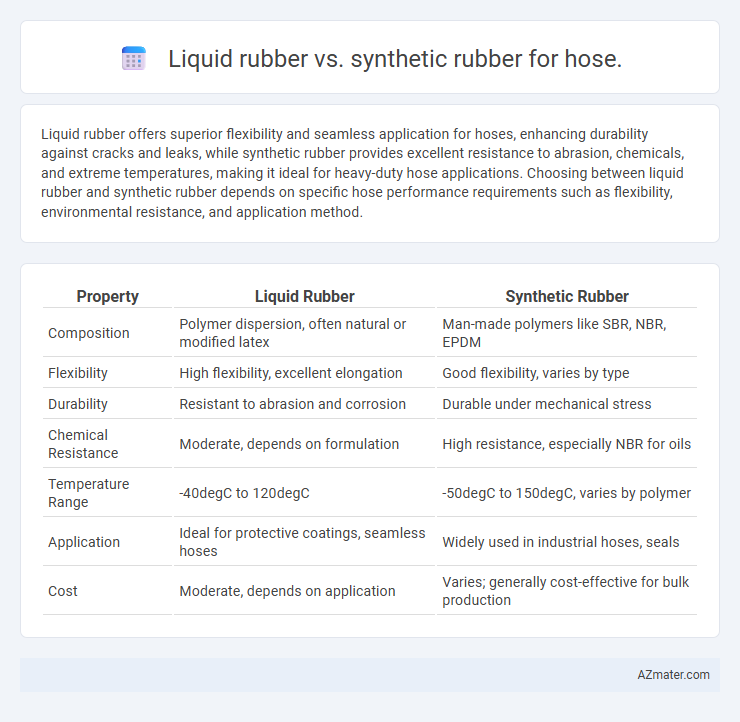Liquid rubber offers superior flexibility and seamless application for hoses, enhancing durability against cracks and leaks, while synthetic rubber provides excellent resistance to abrasion, chemicals, and extreme temperatures, making it ideal for heavy-duty hose applications. Choosing between liquid rubber and synthetic rubber depends on specific hose performance requirements such as flexibility, environmental resistance, and application method.
Table of Comparison
| Property | Liquid Rubber | Synthetic Rubber |
|---|---|---|
| Composition | Polymer dispersion, often natural or modified latex | Man-made polymers like SBR, NBR, EPDM |
| Flexibility | High flexibility, excellent elongation | Good flexibility, varies by type |
| Durability | Resistant to abrasion and corrosion | Durable under mechanical stress |
| Chemical Resistance | Moderate, depends on formulation | High resistance, especially NBR for oils |
| Temperature Range | -40degC to 120degC | -50degC to 150degC, varies by polymer |
| Application | Ideal for protective coatings, seamless hoses | Widely used in industrial hoses, seals |
| Cost | Moderate, depends on application | Varies; generally cost-effective for bulk production |
Introduction to Liquid Rubber and Synthetic Rubber
Liquid rubber is a versatile coating material known for its excellent elasticity, waterproofing properties, and chemical resistance, often used to protect and seal hoses. Synthetic rubber, derived from petrochemicals, offers enhanced durability, abrasion resistance, and temperature stability, making it ideal for industrial hose applications. Both materials provide distinct advantages in hose manufacturing, with liquid rubber serving primarily as a protective layer and synthetic rubber forming the core elastomeric structure.
Key Differences Between Liquid and Synthetic Rubber
Liquid rubber offers superior flexibility and seamless application compared to synthetic rubber, which is typically pre-formed and less adaptable for complex shapes. Synthetic rubber provides greater resistance to heat, chemicals, and abrasion, making it ideal for high-pressure hose environments. The curing process differs significantly: liquid rubber cures through exposure to air or UV light, while synthetic rubber requires vulcanization, influencing production speed and durability.
Properties and Performance of Liquid Rubber in Hose Applications
Liquid rubber exhibits superior flexibility and excellent adhesion properties, making it ideal for hose applications that require durability and resistance to environmental factors. Its exceptional resistance to UV rays, chemicals, and temperature fluctuations ensures long-lasting performance even in harsh conditions, outperforming many synthetic rubber alternatives. The seamless coating provided by liquid rubber enhances hose leak protection and extends service life by preventing cracks and wear.
Advantages of Synthetic Rubber for Hoses
Synthetic rubber offers superior durability and resistance to extreme temperatures, chemicals, and abrasion, making it ideal for hose applications exposed to harsh environments. Its flexibility and tensile strength enhance hose performance, ensuring longer service life and reduced maintenance costs. Synthetic rubber hoses also provide excellent resistance to ozone and UV degradation, maintaining integrity in outdoor and industrial settings.
Durability and Flexibility: Liquid vs Synthetic Rubber
Liquid rubber offers superior flexibility due to its ability to form seamless, waterproof coatings that resist cracking under extreme temperature variations, enhancing hose durability in dynamic environments. Synthetic rubber, such as neoprene or EPDM, provides excellent abrasion resistance and tensile strength but may become brittle over time when exposed to UV light or chemicals. Choosing between liquid rubber and synthetic rubber for hoses depends on the specific application requirements, balancing long-term flexibility with resistance to mechanical wear and environmental degradation.
Chemical Resistance Comparison
Liquid rubber exhibits superior chemical resistance compared to synthetic rubber in hose applications, effectively withstanding a wide range of acids, alkalis, and solvents without degrading. Synthetic rubber, while offering good resistance to oils and fuels, often suffers from swelling or cracking when exposed to harsh chemicals like strong acids or oxidative agents. This makes liquid rubber an ideal choice for hoses used in aggressive chemical environments, ensuring longer service life and reduced maintenance costs.
Temperature Tolerance in Industrial Settings
Liquid rubber offers superior temperature tolerance for hoses in industrial settings, withstanding extreme temperatures ranging from -40degC to 150degC without degradation. Synthetic rubber, such as EPDM or nitrile, typically operates efficiently within a narrower temperature range, generally from -30degC to 120degC. This makes liquid rubber more suitable for applications involving fluctuating or high-temperature conditions, ensuring durability and performance stability.
Environmental Impact and Sustainability
Liquid rubber offers superior environmental benefits compared to synthetic rubber for hose applications, as it is often derived from renewable resources and features low VOC emissions during application. Synthetic rubber production typically relies on petroleum-based raw materials, contributing to higher carbon footprints and non-renewable resource depletion. The biodegradability and recyclability of liquid rubber also enhance sustainability efforts by minimizing long-term environmental impact.
Cost Considerations for Hose Manufacturers
Liquid rubber offers hose manufacturers a cost-effective solution with lower raw material expenses and reduced application waste compared to synthetic rubber. Synthetic rubber typically demands higher processing costs due to complex compounding and curing requirements, increasing overall production expenses. Manufacturers must weigh the initial material costs and long-term durability benefits of each type to optimize budget efficiency in hose production.
Choosing the Right Rubber for Hose Applications
Liquid rubber offers superior flexibility and excellent adherence to various hose substrates, making it ideal for custom or repair applications requiring seamless coating and waterproofing. Synthetic rubber, such as nitrile or EPDM, provides high resistance to abrasion, chemicals, and extreme temperatures, ensuring durability in industrial and heavy-duty hose applications. Selecting the right rubber depends on factors like environmental exposure, mechanical stress, and compatibility with transported fluids to optimize performance and longevity.

Infographic: Liquid rubber vs Synthetic rubber for Hose
 azmater.com
azmater.com